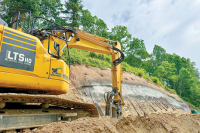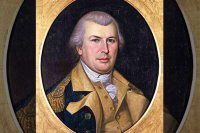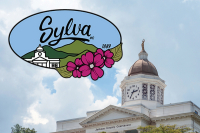Book lovers and our new bookplates
Several weeks ago, I devoted a column to the complicated science of book shelving. Not a few readers responded — often with descriptions of their systems, which they deemed infallible.
Shelving by fiction and non-fiction and leaving it at that seems sort of lazy to me, hardly worth the effort. Nevertheless, that method had several adherents, none of whom gave a hoot when I suggested they might be lazy if not slovenly shelvers. They were happy and didn’t care what I thought.
One lady proudly claimed to have “thousands of books scattered around the house, none of them shelved.” When I replied (in an email) that I hoped she was kidding, she wrote back to say she wasn’t kidding and offered to send a picture of her “book jungle” that I declined.
Most respondents shelved by subject categories of some sort: boats, animals, countries, etc. — and then arranged their books alphabetically within each category. No one else also broke them down chronologically, as I do; that is, I first shelve by general categories, say, natural history. Those books are then divided into British and American. Books up until 1900 are arranged chronologically (Thoreau would come before John Burroughs), but post-1900 books are alphabetical (Annie Dillard comes before Gretel Ehrlich). I don’t know how or why this system of mine originated, but it is infallible.
It should be noted before we move on that almost everyone, as a last resort, approved of the Dusty Miller school of book shelving. Dusty Miller was the much admired London bookseller I described in the column who, when asked how he arranged his books, replied that, “When I buy a short fat book I try to find a short fat hole.” For the lady who doesn’t shelve anything, this wasn’t an issue.
The response to the shelving column surprised me. In Western North Carolina, the love of and care for books seems to be alive and well. Or maybe the point is that readers of The Smoky Mountain News tend to be bookish. And the corollary to that would be that bookish people seem to seek out The Smoky Mountain News in both print and online editions. Why not? It’s a weekly regional newsmagazine situated off-the-beaten track in the southern mountains that features two wonderful written book reviewers, another general column (this one) that discusses older books with frequency, and a natural history columnist who is as likely to focus on a book almost as frequently as he does pileated woodpeckers.
Related Items
Without this sort of feedback, I probably wouldn’t be inclined to write about bookplates. But there appears to be an audience out there that wouldn’t mind considering bookplates. Here goes.
For years, I’ve admired them and thought about coming up with one for our books that would be appropriate. I like the way a nice bookplate dresses up a nice book. I don’t have a rare or fancy collection of books by any means, but I do have many books that would look good with a bookplate, as does my wife, Elizabeth, who has a nice collection of art and papermaking books. I keep using the word “nice” so as to emphasize that we’re not talking about rare first editions or leather-bound books. We’re just talking about “nice” books — not tattered hardbacks or cheap paperbacks (although some quality soft cover books are “nice”) — of the sort everyone reading this has in their home.
Another reason for thinking about a bookplate is that I have signed most of our books on the front flyleaf. Some signatures are pleasant looking, even elegant. My signature is downright ugly. It used to be as big as a barn door. These days, as I get older, it’s becoming microscopic. Either way, it’s not a pretty thing to encounter. A bookplate would cover up most of my signatures.
Through the years, I’ve picked up several books with chapters on the history of bookplates. There’s no need to go into that sort of detail here. Some excerpted background I summoned up in about five seconds by entering “bookplates” in the Google search engine will suffice:
“A bookplate, also known as ex-Libris [Latin,’ from the books of’], is usually a small print or decorative label pasted into a book, often on the inside front cover, to indicate its owner. Simple typographical bookplates are termed ‘booklabels.’ Bookplates typically bear a name, motto, coat of arms, or any motif that relates to the owner of the book. The earliest known marks of ownership of books or documents date from the reign of Amenophis III in Egypt (1391-1353) ... The earliest known examples of printed bookplates are German, and date from the 15th century ... Although the majority of the older plates were armorial, there were always pictorial examples as well [including] landscape-plates by wood engravers of the Bewick school ... In 1901-1903 the British Museum published the catalog of the 35,000 bookplates collected by Sir Augustus Wollaston Franks (1826-97).”
I included the reference to “landscape-plates” because that’s what Elizabeth and I finally came up with, using one of her idealized renderings in watercolor of the cove where we live. The same image appeared on the cover of one of our books, Mountain Passages (2005). So, the bookplates that arrived last week have personal significance, for us — all the more so, because our friend, Asheville artist Ann Smith, designed the 1,300 plates that arrived last week from a printer she works with. Ann describes them as “four-color with bleeds, peel and stick plates — uncoated (matte) finish — 3 x 4 inches.”
They’re better than nice. If you’ve ever thought about a bookplate to dress up your nicer books, I can affirm that you would in all likelihood enjoy doing so.
Considering the rate at which I am presently proceeding, I should be finished with the mounting process of these 1,300 plates in about 2015 or so.
George Ellison wrote the biographical introductions for the reissues of two Appalachian classics: Horace Kephart’s Our Southern Highlanders and James Mooney’s History, Myths, and Sacred Formulas of the Cherokees. In June 2005, a selection of his Back Then columns was published by The History Press in Charleston as Mountain Passages: Natural and Cultural History of Western North Carolina and the Great Smoky Mountains. Readers can contact him at P.O. Box 1262, Bryson City, N.C., 28713, or at This email address is being protected from spambots. You need JavaScript enabled to view it..









